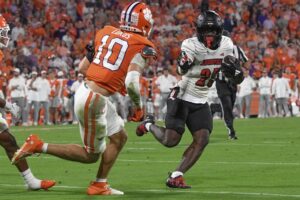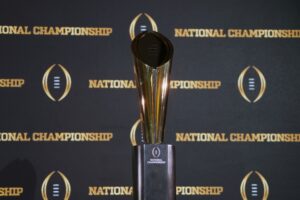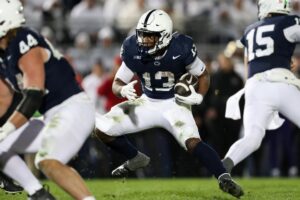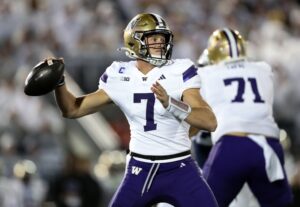UCLA football continues its ongoing metamorphosis under new coach Chip Kelly. Many are writing, and guessing, about what the UCLA offense is going to look like under Kelly.
He will be the de-facto offensive coordinator, and as such the fourth OC in five years in Westwood. There are too many unknowns in Spring to draw many definitive conclusions. The offensive line is still thin in terms of depth. The quarterback question is still just that; a question, particularly until Dorian Thompson-Robinson arrives this Summer. Devon Modster continues to improve, but a competition awaits.
UCLA Football; Ready To Receive
There is also a lot of “mis-remembering” about what a Kelly college offense looks like. It has been six years since he walked the sidelines in Eugene. While his Oregon teams racked up big numbers in terms of points and yardage, it was always about pace, clock management, and getting more snaps out of the offense as a result. That means for all the unknowns about UCLA’s offense as we near mid-April, a review of Oregon videos from the Kelly era does allow us to correlate some of his past to the present-day UCLA roster.
One supposition that we are going to get to has to do with the receiving corps. Based on Kelly’s teams at Oregon, it is going to be about diversity and depth.
In four highly successful years at Oregon, Kelly never had a season where fewer than eight different receivers (wide receivers or tight ends) had catches. In some years that number was as high as 12. And then there were the running backs. If you are going to play for Chip Kelly, you must be able to run the ball, but you also must be able to catch it out of the backfield. In those four years, there were as many as four running backs with catches.
Again though, this is not about slinging the ball around the field 50 times per game. This was about measured, ball control speed. To have that, it requires different types of receivers and tight ends. The Oregon game films from 2009-2012 show a mix of ball catchers. Some had breakaway speed. Others possessed greater size and created match-up problems against smaller defensive backs. There were the precise route runners, or the guys who could climb the ladder over the middle. The tight ends did more than sit down in space against a zone. The running backs were on wheel routes or sneaking out on simple screens.
Kelly’s first year at Oregon was the lowest output of the four years. There were eight wideouts/tight ends with receptions. Six of them had double figures in catches. Receiver Jeff Maehl led the team with 53 catches and tight end Ed Dickson was second with 42. There were also four running backs with catches. Here is Chip Kelly at work. Maehl was a lightly recruited 5-11 defensive back in the high school class of 2007, who Kelly turned into a receiver with immediate results. Dickson was an athletic, bruising tight end. Diversity.
In 2010, new Oregon quarterback Darron Thomas added nearly 1,000 yards to the team passing totals, and he used 12 different receivers/tight ends and four running backs. The leading receiver was cornerback-turned-wideout Maehl with 77 catches. The top five pass catchers had totals ranging from 24 receptions to Maehl’s 77.
Thomas had similar numbers in 2011, utilizing 10 receivers/tight ends and three running backs. Wide receiver Lavasier Tuinei led the team with 48 receptions. Running back De’Anthony Thomas was actually second on the team with a staggering 46 receptions. There were five receivers in double figures and three running backs in doubles figures.
Kelly’s last season, 2012, was also the first season for future Heisman winner Marcus Mariota. The passing yards dropped off a little, but there were still 11 receivers/tight ends in the mix and two running backs. Thomas had another 45 receptions out of the backfield and running back Kenjon Barner had another 20. Josh Huff led the receivers with 32 catches, but linebacker-turned-into-tight end Colt Lyerla also had 25.
In all four seasons, with three different quarterbacks and the usual turnover of college football rosters, Kelly’s offense was spreading the ball around. The Ducks always had double figures in receivers with catches. A tight end was always in the top four of the group. There were usually at least five receivers and two running backs with double figures in receptions.
So, connect the dots to UCLA. The Bruins did not have diversity and depth in catching the ball in 2017. They were quite top-heavy. Jordan Lasley had 69 receptions. Darren Andrews had 60, pre-injury. Both are now gone. Yes, Theo Howard had 56, but that number is deceiving because 20% of his total for the year was in one game, (USC). Howard had nine games with four or fewer catches. It’s a long drop off to Caleb Wilson who had 36 catches and missed the last eight games with an injury. As for the running backs, Soso Jamabo and Bolu Olorunfunmi had a combined 27 catches out of the backfield. That is one-half of a De’Anthony Thomas season in Eugene. Changes must be in the making.
If you look at what UCLA has coming back, some conversions in process at camp and who Kelly signed in a compressed recruiting season you can envision some subtle difference already. Remember, depth and diversity.
Theo Howard; Has the break away sideline speed. Blocking ability has been the only thing stunting his playing time. Was too physical for SC’s highly touted defensive backs last year.
Caleb Wilson; Was Josh Rosen’s favorite receiver early on last season prior to injury. Missing spring camp with non-football wrist injury. While listed as a tight end, could easily be used as a slot receiver in intermediate routes with his size.
Devin Asiasi; Tight end transfer from Notre Dame. Listed a 6-3, 287 but dropped a visible 10 pounds prior to Spring camp. Has been running a lot of non-traditional tight end out routes in camp and shows solid footwork.
Jordan Wilson; At 6-5, 265, more of a traditional tight end frame and has been working as such at camp. Has shown good hands, but the drills have not gone over the middle in a zone much yet.
Christian Pabico; His status as a walk-on means nothing here. He had 18 catches last season, clearly put in a lot of work in the off-season and is having a good Spring. Imagine a good possession receiver who will go to any part of the field for you. The routes have been strong in camp. The hands have been good. Where depth matters, he is worthy of more targets.
Dymond Lee; Has shown some of the best hands of camp. Came to UCLA as a QB but needed to convert to see the field. At 6-2, 174, does not have the size to mix it up with linebackers, but get him past the second tier and he will be a match-up problem for defensive backs.
Chase Cota; Size creates problems for defenses. Last week was his first at camp, but it took no time too see he could pick up the routes quickly. Fluid motion for his 6-4 frame and precise route running. Not sure how a bunch of 6-0 defensive backs throughout the conference are supposed to defend him.
Kyle Philips; Need to see more of him in Spring, but even at only 6-0, he runs a 4.49 40, so there is that outside speed thing again. Also has terrific yards after catch abilities.
Bryan Addison; Will be here in the Summer. Recruited to play defensive back and receiver. At 6-5 with tons of speed creates match-up problems for the defenses.
Olorunfunmi/Jamabo/Brandon Stephens; No matter how good they are carrying the ball, their time on the field is going to be determined by their ability to catch out of the backfield.
If you take what Chip Kelly did with the offense at Oregon and transmogrify it forward six years, it is logical to expect the new generation to have a lot of run-pass-option, (RPO), orientation to it. Regardless of who winds up winning the starting quarterback job, if everyone is doing the job they were brought in to do, the success of the offense is going to rely heavily on depth and diversity within the group on the receiving end of what the quarterbacks are putting out there.






